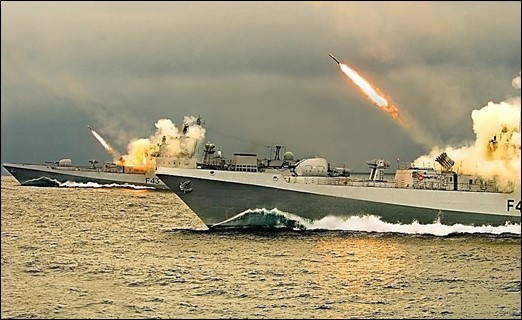
The Indian Navy’s Improving Arsenal: Building Strategic Maritime Might!

The Indian Naval Ensign bears the maxim ‘Sham No Varuna’, invoking the blessings of the Lord of Water. The Octagon of the Naval Ensign is an emulation of the royal seal of one of India’s greatest warriors- Chhatrapati Shivaji Maharaj, who, incidentally, was instrumental in raising the Maratha Navy- one of India’s first indigenous Naval Forces! Surely, such an ode to warriorship will behoove India’s maritime force to develop and maintain cutting-edge operational readiness, efficiency and lethality- and therefore an arsenal that is capable of bringing an adversary quickly to the negotiating table!
In the latest embodiment of lethality/ indigenisation of the Indian Navy’s (IN’s) arsenal, the Varunastra, an Anti-Submarine warfare (ASW) ship launched heavy-weight torpedo (HWT), was test-fired with a live warhead during a combat firing exercise from a Kamorta-class ASW corvette off India’s Western Seaboard on 06 June 2023. The HWT successfully destroyed an undersea target at a range of 40 Km, thus effectively underlining the IN’s lethality in the surface/ sub-surface domains!
Some of the enunciated missions of the Indian Navy (IN) in this context include Nuclear second strike, Sea Control/ Denial, Blockade of adversary ports/ maritime regions, Power/Force Projection, Compellence to ensure compliance/ Destruction of the adversary’s maritime resources, Interdiction of adversary’s Sea Lines of Communication and protection of our own, Seaward/ Coastal/ Offshore Defence and Special Forces Operations. All of these, without exception, require the IN to hone and advance its arsenal to be able to stay ahead of any potential adversary in terms of coercive capability- in short, the need to possess cutting-edge weaponry!
Apropos, this article will represent a profile of major advancements/ acquisitions in weapons/ weapon systems undertaken by the IN to fulfill the above mission profiles.
Ship-Launched Surface-to Surface Missiles
The IN successfully tested the ship-launched version of the BrahMos supersonic cruise missile from the frontline stealth guided-missile destroyer, INS Kolkata, in the Arabian Sea on 04 March this year and successfully intercepted a surface target. The ship-launched variant with the ability to hit maritime targets beyond the radar horizon was inducted into the IN in 2005 in inclined-launch configuration on INS RAJPUT, a Destroyer Class ship. The cruise missile, with a speed of close to 3 Mach, incorporated an indigenous seeker, navigation module and booster, thus underlining India’s self-reliance in the Defence industry, a fact endorsed by a number of nations that have acknowledged this game-changer. This list includes the Philippines, which in March 2021, signed an arms agreement with India, which includes the BrahMos missile; with Russia and several countries from South-East Asia, Latin America and the Middle-East showing keen interest. The submarine-launched variant was successfully test-fired in March 2013 in vertical launch configuration from a submerged platform. The missile is capable of sub-surface launch from a depth of 40 to 50 m. The submarine-launched version of the BrahMos will be incorporated into India’s new Project P-75 (I) submarines (read more @https://chanakyaforum.com/indias-submarines-towards-regional-dominance/). Presently, the ship-launched anti-ship and land-attack versions of the BrahMos have been inducted and are operational. Read about BrahMos in detail @ https://chanakyaforum.com/brahmos-cruise-missile-indias-contender-in-the-supersonic-vector-race/ ). The BrahMos would augment the Dhanush (Prithvi-III) Surface-to-Surface Missile (SSM), which was last successfully test-fired by the Strategic Forces Command in the Bay of Bengal in February 2018. The SSM was launched from a Sukanya-class offshore patrol vessel mounted with the hydraulically stabilised launch platform required to launch the missile. The Dhanush SSM can mount a conventional or nuclear warhead and has a max range of 350 Km with a 1000 Kg warhead, making it the most potent variant in the Prithvi series, for engagements at sea/ land-attack/ interdiction role from either of India’s seaboards.

BrahMos Ship-Launched Version Being Fired from INS Kolkata in March 2023: Source-thehindu.com
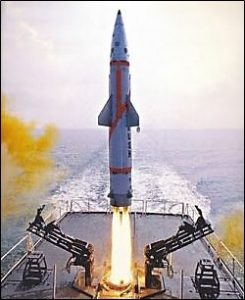
Dhanush Being Test-Fired: Source – missilethreat.csis.org
K-Series Submarine Launched Ballistic Missiles (SLBMs)
Under India’s Advanced Technology Vessel (ATV) Program, which covers the development and manufacture of four nuclear submarines, India’s first SSBN, INS Arihant, was commissioned in August 2016. In November 2017, India launched the second SSBN, INS Arighat. Both SSBNs can carry four/12 nuclear-capable K-4 / K-15 (Sagarika) Submarine Launched Ballistic Missiles (SLBMs) with a range of 3500-4000 Km/ 750 km respectively (the latter currently forming part of INS Arihant’s arsenal, with INS Arighat yet to be commissioned). The successful test-firing from INS Arihant on 14 October 2022 in the Bay of Bengal is likely to have been of a K-15 SLBM. The remaining two nuclear submarines (S4 and S4*) are yet to be named and would likely have enhanced flexibility of carrying SLBMs (8 missile launch tubes to carry up to 8 K-4 or K-5 missiles). Both the missiles mount two-stage solid fuel boosters and employ the Indian Regional Navigation Satellite System (IRNSS- NavIC), thus ensuring insulation against mid-flight interference by an adversary. Both these missiles form an important facet of India’s nuclear triad. On the anvil, the K-5 solid-fuel, three-stage nuclear-capable missile is reportedly also being developed by DRDO as an SLBM and would arm the future S4 and S4* of the Arihant Class SSBNs. This SLBM is likely to be in the ICBM category with a range of over 5000 km. The K-6 SLBM is also reportedly under development by DRDO’s Advanced Naval Systems Laboratory in Hyderabad and would derive inputs from future tests of the K-5 SLBM. The missile is likely to be in the ICBM category with a range of up to 8000 Km. It would be a solid-fuel, three-stage nuclear-capable missile with Multiple Independently Targeted Reentry Vehicle (MIRV) capability, thus allowing true strategic reach! It is slated to arm the S4* submarine of the Arihant Class. All these vectors except the K-15 are capable of striking targets within China (which obviously includes targets inside Pakistan as well), with the K-15 focused towards regional engagements in the sub-continent.
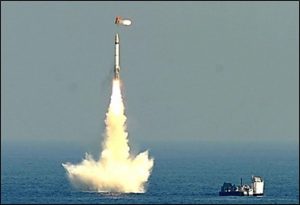
Underwater Test Launch of K-15 in the Bay of Bengal: Source-drdo.gov.in
Naval Anti-Ship Missile–Medium Range (NASM-MR)
The NASM-MR is an indigenous anti-ship missile being developed by DRDO for the IN. The initial variant of this medium-range Harpoon Class missile (referring to an all-weather, over-the-horizon, anti-ship vector) is likely to have a range of upto 290 Km with a speed of Mach 0.8. It will be developed as an air-launched variant for fighter aircraft such as the LCA TEJAS, the Rafale-M and the Twin-Engine Deck Based Fighter (TEDBF: being developed for the IN) (read more @ https://chanakyaforum.com/lca-tejas-ready-to-touch-the-skies-with-glory/ ) and IN’s Maritime Patrol Aircraft (MPA) such as the P8I Neptune, acquired from Boeing over two contracts in 2009 and 2016. The missile would mount a 150 Kg multiple Explosively Formed Penetrator (shaped charge) warhead designed for penetration into a submarine hull. A second canisterised variant, with a solid-fuel rocket booster to achieve ranges upto 350 Km, will be developed for the IN’s frontline warships for use against small to medium-sized surface ships such as an adversary’s frigates, corvettes and destroyers. The third variant will be developed as a solid-fuel, torpedo tube-launched SLBM, with a range of up to 250 Km. There is also a likelihood that the missile will be developed for use with coastal defence batteries, with the principal aim of export to friendly countries.
Extended-Range Anti-Submarine Rocket (ER-ASR)
Aligning with the requirements espoused in the Technology Perspective and Capability Roadmap (TPCR) -2018, a vision document for capability-building for the Indian Armed Forces in this decade, DRDO has successfully developed the ER-ASR to enhance the range of existing RGB-60 Anti-Submarine Rocket, fired from the RBU-6000 launcher, from 5.3 km to 8.0+ km. The RBU-6000 Smerch-2 is a 213 mm calibre Soviet-era ASR launcher. ER-ASR consists of two motor propulsion systems that can fire the rocket in Short/Long Range mode. The enhanced ranges allow the ER-ASR to target torpedoes much further out at sea/ allow enhanced reaction for manoeuvering in case of a miss. This significantly enhances the survivability of surface ships equipped with the RBU-6000 system, which include frontline destroyers and stealth frigates, among others. In a further step towards self-reliance, the IN earlier this year received for the first time a fully indigenised YDB-60 fuze for the ASR.
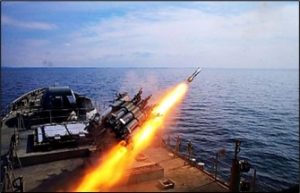
IN’s Stealth Frigate, INS Tabar, Firing an ASR
Varunastra HWT
As already alluded to earlier, the Varunastra HWT, designed by the Visakhapatnam-based Naval Science and Technological Laboratory (NSTL) of DRDO and being manufactured by Defence PSU Bharat Dynamics Ltd (BDL) under a contract worth approximately INR 1,200 Crores, was test-fired on 06 June 2023. While the HWT was inducted into the IN in 2016, this was the first time the torpedo was tested with a live warhead in a combat setting. The HWT will give a much-needed fillip to the IN’s ASW capabilities, given its long range and phenomenal accuracy. The Varunastra is slated to become the standard ASW weapon, replacing older versions of HWTs on surface ships capable of delivering such ordinance. The HWT is GPS guided and electrically-propelled, with an insensitive munitions warhead. It is therefore capable of targeting even quiet submarines, both in deep and shallow waters in an intense counter-measures environment, while significantly reducing the risk of detection due to its relatively silent propulsion. The HWT is reportedly capable of reaching a top speed of 74 Kmph and can manoeuvre at a depth of 400-600 m below the surface, with a 250 Kg warhead. The torpedo enjoys a low-drift navigational system (greater accuracy over long distance), acoustic homing, advanced acoustic countermeasure features and autonomous guidance. These statistics compare globally with the most advanced HWTs.
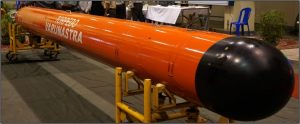

Varunastra, Being Test-Fired: Source-drdo.gov.in
Shyena Lightweight Torpedo
The Advanced Light Torpedo (TAL) Shyena, also developed by NSTL, holds the distinction of being the IN’s first indigenous lightweight anti-submarine torpedo. This electric-propulsion, processor-based torpedo can be launched from ships / submarines / aerial ASW platforms and has solid-state electronics, digital control and guidance systems and an integrated active/passive homing sensor package. The TAL has an operational range/operating depth of 19 Km/450m respectively and a max speed of 61 Kmph, with the operational version weighing 220 Kg. Its key design features are manoeuverability and ability to transition from warm to cold medium to ensure a ‘hunt and kill’ in shallow as well as deep waters. It performs pre-programmed search patterns, detects an underwater target and homes on with its integrated sensor package. On 8 March 2021, the IN successfully cleared the TAL’s maiden flight-trial with a parachute system from the Russian Ilyushin IL-38 MPA. Shyena has since been exported to Myanmar and other friendly foreign countries.
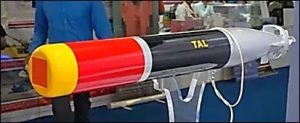

TAL at DefExpo 2022, Being Fired From a Ship-based Launcher: Source-firstpost.com/ drdo.gov.in
Conclusion
While the above list of the IN’s growing weapon arsenal may not be completely exhaustive, the elucidation of the major surface and sub-surface maritime weapon systems above represents an unambiguous pointer towards the focus and efforts that are now emplaced in enhancing the lethality of the IN and establishing its position as a regional Naval force with strategic reach!
Disclaimer
The opinions expressed in this article are the author’s own and do not reflect the views of Chanakya Forum. All information provided in this article including timeliness, completeness, accuracy, suitability or validity of information referenced therein, is the sole responsibility of the author. www.chanakyaforum.com does not assume any responsibility for the same.
Chanakya Forum is now on . Click here to join our channel (@ChanakyaForum) and stay updated with the latest headlines and articles.
Important
We work round the clock to bring you the finest articles and updates from around the world. There is a team that works tirelessly to ensure that you have a seamless reading experience. But all this costs money. Please support us so that we keep doing what we do best. Happy Reading
Support Us





















POST COMMENTS (0)